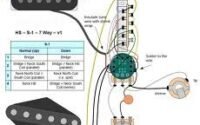Out-of-phase Guitar Pickups Explained
Out-of-phase pickups versus in-phase pickups

A bit of theory might help.
Guitar pickups are magnets that capture the vibration of the guitar strings and convert them into an electrical signal that can be amplified. The difference between out-of-phase and in-phase pickups lies in how the magnetic fields generated by the two pickups interact.
In-phase pickups produce aligned magnetic fields and amplify the string vibrations similarly, resulting in a complete and balanced sound. This is the most common wiring for guitar pickups and is excellent for various music styles.
Out-of-phase pickups
Out-of-phase pickups produce magnetic fields opposite to each other and thus cancel out some frequencies in the sound. This results in a thin, “quacky” sound that is often used for specific tonal effects, particularly in jazz and blues music.
The choice between in-phase and out-of-phase pickups will largely depend on the desired tone and musical style.
In-phase pickups
In-phase guitar pickups produce a stronger, punchier sound as the pickups are wired to generate the same magnetic field and respond to it in the same direction. This results in a combined signal that is stronger and more defined.
Out-of-phase pickups are wired so that their magnetic fields are in opposition to each other. This produces a weaker signal but with a more distinctive and hollow tone. This is often used to create a unique tonal effect and can be especially useful for achieving a “quack” or “spank” tone when playing single-coil pickups in the middle position on a Stratocaster-style guitar.
Not all pickups sound good out-of-phase
 Some examples of good out-of-phase guitar pickups:
Some examples of good out-of-phase guitar pickups:
- Fender Telecaster pickups
- Seymour Duncan STK-S4
- DiMarzio DP100 Super Distortion
- Gibson P-90 pickups
- EMG SA pickups
These pickups are known for their unique tonal characteristics and are favored by guitarists looking for a quacky and twangy sound. It is worth noting that not all guitar pickups have the option to be wired out-of-phase and it is essential to check the specifications of the pickups before making any modifications to the wiring.
Things to check before wiring out-of-phase guitar pickups
Before wiring guitar pickups out-of-phase, it is essential to check the following:
- Compatibility: Not all pickups can be wired out-of-phase. Some pickups are not designed to be wired this way and may not produce the desired tone or damage the pickups or amplifier. It is essential to check the specifications of the pickups to see if they can be wired out-of-phase.
- Wiring diagram: Wiring guitar pickups can be complex, and it is essential to clearly understand the wiring diagram before making any changes. Follow a reputable wiring diagram to avoid damaging the pickups or the guitar.
- Tools and equipment: Wiring guitar pickups requires a few tools such as wire stripper, soldering iron, and heat shrink tubing. Make sure to have these tools available before beginning the wiring process.
- Safety: Wiring guitar pickups involves working with electrical components, and it is essential to take necessary safety precautions, such as unplugging the guitar from the amplifier and avoiding contact with live wires.
By checking these things before wiring out-of-phase pickups, you can ensure that the process goes smoothly and you achieve the desired tone.
Out-of-phase pickups wiring
Wiring guitar pickups out-of-phase involves changing the way the pickups are connected to the volume and tone controls. This changes the electrical signal produced by the pickups, resulting in a thin, quacky sound.

Here is a basic outline of the wiring process:
- Gather tools and equipment: You will need a soldering iron, wire stripper, heat shrink tubing, and a wiring diagram.
- Disconnect power: Make sure to unplug the guitar from the amplifier to avoid any electrical shocks.
- Locate the pickup leads: The pickup leads are the wires that connect the pickups to the volume and tone controls.
- Reverse the pickup leads: To wire the pickups out-of-phase, you will need to reverse the leads for one of the pickups. This means that the hot and ground wires will be swapped.
- Solder the leads: After reversing the leads, you will need to solder them back to the volume and tone controls. Make sure to use heat shrink tubing to cover the soldered joints and prevent any short circuits.
- Test the wiring: Once the wiring is complete, plug the guitar back into the amplifier and test the sound. You should hear a thin, quacky sound that is characteristic of out-of-phase pickups.
Wiring guitar pickups out-of-phase is a technical process that requires a good understanding of electronics and a steady hand. If you are not confident in your ability to wire the pickups, it may be best to seek the help of a professional technician.
Some of Hervé Senni Wiring featuring out-of-phase pickups
- Skulled SG Featuring Bill Lawrence Pickups and 3X3-05 Free-Way Toggle (Ultra)
- Harley Benton Thinline modified with Guitarfetish P180 pickups
- Artec Electronics Active EQ & Booster on a 24 Frets Custom Guitar – Artec MP3 & Artec QTB
- Electric Guitar Kit – Les Paul Junior Double Cutaway Kit – Tonerider Rebel 90 pickups & Artec BCU
- Red Special Wiring Schematic Using Only 3 On-On-On Toggle switches – PTB Tone Control & Solo Switch
I am Hervé Senni, a pro musician and performer, Composer and arranger for quite some time. My main musical instrument is the electric guitar. I am also a bass player, mandolin, Ukulele player. I also invented string instruments.
Over the years, repairing and improving electric guitars that did not have to be upgraded converted me into a self-taught luthier.




